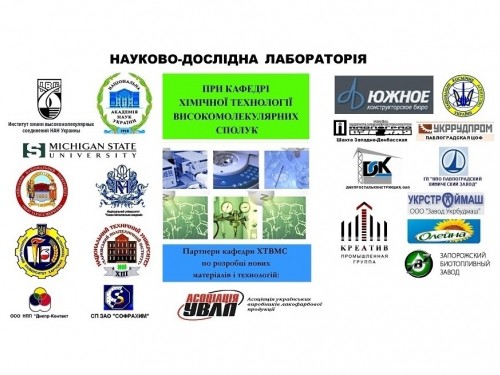DEPARTMENT OF NATURAL AND SYNTHETIC POLYMERS, FATS AND FOOD PRODUCTS

Scientific Activity of the Department
Film materials for special purpose
New ionogenic materials based on polymer quaternary ammonium salts
Crosslinked film materials have static exchange capacity up to 5.0 mg-ekv / g, ionic conductivity up to 10-2 cm / cm, strength at stretching 35-40 MPa and water absorption at 30-40%.
They are characterized by increased resistance to the effect of thermo-oxidation degradation and the action of strong inorganic acids.
New ionogenic materials based on sulfonic acid derivatives of polyamide
Crosslinked film polymeric materials based on condensation products of PA-6 polyamide, aromatic sulfonic acids and formaldehyde have a static exchange capacity of 2.5 – 3.0 mg-eq / g, ionic conductivity up to 4.5 × 10-3 cm / cm and water absorption at the level of 40-70%.
On their basis, it is possible to obtain reinforced film materials, organo-inorganic composites and polyelectrolytic complexes.
New ionogenic materials based on sulfonic acid derivatives of polyvinyl alcohol
Cross-linked film materials based on condensation products of polyvinyl alcohol, aromatic sulfonic acids and formaldehyde have a static exchange capacity of 1.4 – 3.0 mg-eq / g, ionic conductivity up to 10-2 cm / cm, tensile strength of up to 50 MPa, and water absorption at the level of 60-80%.
Film materials of all these types can be used as matrices of polymeric electrolytes and membranes for electrochemical devices of various applications (fuel and solar cells, gas sensors, electrodialysis membranes, etc.) and for use in sorption processes, water treatment systems and heterogeneous chemical catalysis.
Protective coatings and adhesives based on organometallic polymers
Methods of synthesis of silicon, titanium and boronic compounds with functional groups in the hydrocarbon radical (alcohols, amines, isocyanates, epoxides) have been developed. On their basis new polymer materials of a class of polyurethanes and polyeoxides have been created.
Glues
Two-component polyurethane bicomponent adhesives based on oligomeric organometallic alcohols (products of reeteterification of organic derivatives of titanium, silicon or boron) and isocyanate adducts (products of the interaction of a number of polyethylene glycols, which are manufactured industrially and mixtures of isocyanates).
They have high viability, convenient rate of cure (24 hours). The obtained adhesive compounds are characterized by durability at stretching within 4,0 – 5,0 MPa.
Protective coatings
Two-component polyurethane compositions for creating protective coatings of metal and wood surfaces have high hardness (0.6-0.8) and resistance values of direct and reverse impact at level 50.
They can find application for creation of protective and decorative coatings of wooden floors with increased wear resistance.
Foaming compositions
Polymer foam based on synthesized elemental organic polyurethanes has a high starting speed (up to 20s), fast cure time (up to 15 min.), And a wide range of possible densities (15 – 50 kg / m3).
They are used in construction (heat-insulating sheet or block materials), as well as with direct spraying on curvilinear surfaces (insulation of the roof, shells of ships, etc.).
New phenol-formaldehyde oligomers
New phenol-formaldehyde resins contain in their composition modifying additives, which provide them with a unique complex of virtually beneficial properties (low toxicity, increased thermal and chemical stability, moisture resistance, and others).
Low-toxic, water-soluble phenol formaldehyde resins of УК-3-30 have a content of free phenol up to 1%, formaldehyde to 1%, alkali to 1.5%. The dry residue is 59%. Resin is advantageously low in price and in the absence of organic solvents.
According to physical and mechanical characteristics, products based on УК-3-30 exceed the products based on serial LBS-1.
Low-toxic water-soluble phenol formaldehyde resin PK-3-30KO with a content of free phenol up to 1%, formaldehyde to 1%, alkali to 1.5%, which contains up to 10% of organosilicon derivatives. Dry residue 69% Resin is favorably characterized by increased thermal and water resistance, low cost, lack of organic solvents.
Alcohol-soluble phenolpolyamidoformaldehyde resin LBS-M with a dry residue of up to 45%. Composite products based on this resin in their strength characteristics are 2-5 times greater than analogues based on serial LBS-1. Designed for the production of high-strength composite materials. Cost at level LBS-1.
Low-toxic, water-soluble lignophenol formaldehyde resins UC-3-30LF with a content of free phenol up to 0.5%, formaldehyde to 1%, alkali to 1.5%. The dry residue is 59%. Resin is advantageously low in price, lack of organic solvents, low toxicity.
Based on the above-described thermosetting binders and organic or inorganic fiber fillers (polyamide, polyoxidiazole, polybenzimidazole, carbon, glass or basalt fibers), techniques for obtaining such products as high-strength flanges, tabs, sealants, antifriction and friction products, bearings, fasteners , gears and various equipment nodes.
The specified products are characterized by Sharp impact strength exceeding 200 kJ / m2, bending strength up to 350 MPa, compression strength> 300 MPa, heat resistance to Martens to 260 ° C.
Resins УК-3-30 and УК-3-30ЛФ are suitable for the production of modified wood with improved physical and mechanical properties and increased resistance to the action of fungi and rotten microorganisms. Such wood can be used for the manufacture of building decks, frame wooden buildings, as well as any constructions of wood, which are exploited in the conditions of the street. At the same time on the basis of all the above-mentioned resins it is possible to produce moisture-resistant and environmentally friendly DSPP, OSB, MDF and plywood boards.
New water-soluble polymers
New catalytic systems for the synthesis of high molecular weight polyacrylates can produce linear polymers with a molecular weight of up to 10,000,000 without formation of depletion.
Based on industrial anionic polyacrylamides, methods for the synthesis of modified derivatives containing tertiary amine groups and quaternary ammonium salts, respectively, have been developed. Depending on the selected polyacrylamide, polymers with a molecular weight of 1,000,000 to 16,000,000 can be obtained.
Branches of application
- Water-polymeric media for metal hardening
- Aqueous solutions to increase the oil yield of oil fields
- Flocculant
New technologies for the extraction and processing of fatty raw materials
At the moment it is relevant to search for new non-traditional sources of fats. The methods of separating fats from algae biomass (Botryococus braunii) and waste from fat processing industries (not suitable for consumption of beef, chicken and other fats) are developed at the Department.
A characteristic feature of algae is the ability to accumulate in the cell to 75% lipids.
Microphotographs of Botryococus braunii-containing algae and photos of beef fat before and after cleansing
As a result of special technological processing of biomass of algae, liquid hydrocarbon products with a gasoline fraction of 35-45%, kerosene 10-15% and a petroleum product of 40-55% can be obtained.
Heterogeneous catalysts of esterification / perestrification processes of fatty raw materials
On the basis of the selected fatty material, the synthesis of fatty acid esters (EHCs) was carried out by the method of alcohol abuse using heterogeneous catalysts.
As heterogeneous catalysts, new cation exchange polymers based on sulphonic acid polyamide, sulfonic acid polyvinyl alcohol and nanocomposite sulfonic acid catalysts, which are the original development of specialists of the Department, were used.
Sulphonic acid polyamide (SOE 3.0 mg equivalents / g)
Sulfoacid PVS (SOE 2.6 mg-eq / g)
Nanocomposite organo-inorganic catalyst (COE 2.5 mg-eq / g)
Due to the use of cheap raw materials, inexpensive adsorbents and catalysts, the obtained ELCs are attractive and affordable for consumers. They can be used as biofuels, lubricants, plasticizers and more.
Scientific publications:
- Articles
- Conferences
- Educational and methodical work
- Patents
